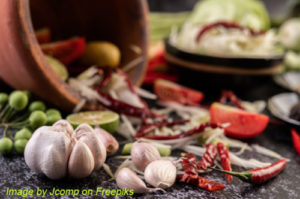This batchoy tagalog recipe is a different from the La Paz batchoy that contains pork offal, chicharon, noodles and egg. Batchoy tagalog primarily used pork inards like liver, heart, kidney, pork belly and pork blood. And there are variations in the noodles used in making batchoy, either misua noodles or miki noodles. The recipe I have here is the way we usually cook the batchoy containing misua, pork blood, pork liver and pork meat such as pork belly or pork shoulder.
A Delightful Filipino Soup
Batchoy tagalog, a savory and hearty soup, stands distinct from the popular La Paz batchoy known throughout the Philippines. While La Paz batchoy is renowned for its rich broth containing pork offal, chicharon, noodles, and egg, the dish showcases the depth of Filipino culinary tradition with its use of pork innards, pork belly, and sometimes pork blood. This version, featuring misua noodles, offers a unique and delicious experience.
The Origins and Evolution of Batchoy
Batchoy, in general, is believed to have originated from La Paz, Iloilo, during the late 1930s. It is said that a Chinese merchant named Federico Guillergan Sr. concocted the first batchoy recipe by combining local ingredients with Chinese cooking techniques, leading to the creation of La Paz batchoy. On the other hand, batchoy tagalog hails from the southern parts of Luzon and showcases a different take on this beloved dish. Instead of focusing on a thick broth laden with offal and noodles, it emphasizes a simpler, more rustic approach, featuring pork liver, pork belly, and pork blood, with a lighter broth that still packs a flavorful punch.
Ingredients and Preparation
The core ingredients for batchoy are what make it stand out: pork liver, heart, kidney, pork belly, and pork blood. This combination provides a rich tapestry of flavors and textures that are both hearty and satisfying. Misua noodles, thin and delicate, are often used in this dish, although miki noodles can also be a substitute. Here, we will follow a traditional recipe using misua.
Preparing the Ingredients
Before cooking, it’s essential to properly season and prepare the pork. Start by seasoning the pork belly or pork shoulder with salt and pepper. This initial seasoning helps to enhance the natural flavors of the meat.
Cooking the Aromatics
The cooking process begins by heating cooking oil in a pot or wok. Saute garlic, onion, and ginger until the onions are soft and translucent. This trio of aromatics forms the base of the soup, infusing it with a fragrant, savory aroma that will permeate the entire dish.
Adding the Flavor
Next, add patis (fish sauce) and let it simmer for a minute on low heat without stirring. This step allows the flavors to meld and deepen, creating a robust base for the soup. After a minute, stir the ingredients to ensure they are well combined.
Cooking the Pork
Add the seasoned pork to the pot and stir until it turns light in color. Cover the pot and let it simmer for about three minutes, or until the fat begins to render from the pork. This step is crucial as it helps develop a rich, savory flavor in the soup.
Incorporating the Liver and Broth
Add the pork liver and stir for about a minute before adding water just enough to cover the meat. Cover the pot and let it simmer until the pork is tender. The liver adds a distinct, earthy flavor to the soup, while the water transforms into a savory broth as it cooks.
Adding the Final Touches
Once the pork is tender, it’s time to add the pork blood. Stir the mixture until it boils, then add siling panigang (green chilies), misua noodles, and dahon ng sili (chili leaves). Let the soup cook for another half a minute before turning off the heat. This final step brings all the flavors together, with the noodles absorbing the savory broth and the chilies adding a subtle heat.
Serving The Batchoy
This batchoy is best served hot, accompanied by rice or puto (Filipino steamed rice cakes). The soup’s rich, hearty flavors make it a perfect comfort food, especially during cooler months.
Nutritional and Cultural Insights
Like many Filipino dishes, reflects the country’s resourcefulness and creativity in cooking. The use of pork innards, often considered lesser cuts of meat, highlights the Filipino tradition of making the most out of available ingredients. Nutritionally, the dish is rich in protein and iron, thanks to the inclusion of pork liver and blood. Misua noodles add a touch of carbohydrates, making the soup a well-rounded meal.
A Cultural and Culinary Delight
Batchoy tagalog with misua is more than just a soup; it’s a reflection of Filipino heritage and culinary ingenuity. Each bowl tells a story of tradition, resourcefulness, and the unique flavors that define Filipino cuisine. Whether enjoyed as a comforting meal on a rainy day or as a hearty dish shared with family and friends, it continues to be a beloved staple in Filipino households.
Batchoy Tagalog with Misua
Ingredients
- 1/2 kilo pork kasim or pork shoulder sliced into cubes
- 1/4 kilo pork liver sliced into cubes
- 2 cups pork blood
- 4 cloves garlic minced
- 1 pc onion chopped
- 1 bunch dahon ng sili
- 1 inch ginger sliced into strips
- 2 pcs long green chilies
- 1 Tbsp. patis
- 1/2 tsp ground black pepper
- 1/2 tsp black pepper powder
- 1 tsp salt
- 50 grams misua noodles
- cooking oil
- water
Instructions
How to Cook Batchoy Tagalog with Misua
- Season the pork with salt and pepper then set aside.
- Heat cooking oil in a pot or wok and saute garlic, onion and ginger. Saute until onions are soft.
- Add patis and simmer for 1 minute in low heat. Do not stir. After a minute stir the the ingredients.
- Add the pork and stir until the pork turns light in color. Then cover and simmer for 3 minutes or until the fat renders from the pork.
- Add the liver and stir for a minute. Then add water just enough to cover the meat. Cover and simmer until the pork is tender.
- Add the pork blood and stir until it boils. Add siling panigang (green chilies), misua and dahon ng sili.
- Let it cook for half a minute then turn off heat. Serve hot with rice or puto.
Video
Notes
Cooking Tips:
Properly Season the Pork
Before cooking, ensure you season the pork belly or shoulder generously with salt and pepper. This initial seasoning enhances the meat's natural flavors and helps to infuse the entire dish with savory goodness. Letting the pork sit for a few minutes after seasoning allows the flavors to penetrate deeper into the meat.Sauté Aromatics Thoroughly
When sautéing the garlic, onion, and ginger, make sure to cook them until the onions are soft and translucent. This step is crucial as it releases the essential oils and flavors from the aromatics, creating a rich, fragrant base for the soup. Sautéing thoroughly ensures that these flavors are well-developed and integrated into the broth.Simmer to Tenderness
After adding the water and liver to the pot, cover and simmer the mixture until the pork is tender. This slow cooking process allows the meat to become succulent and infuses the broth with deep, savory flavors. Patience during simmering is key to achieving the perfect texture and richness in the soup.





